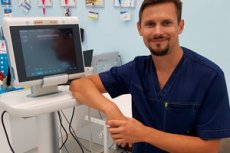Medical expert of the article
New publications
Vein examination
Last reviewed: 04.07.2025

All iLive content is medically reviewed or fact checked to ensure as much factual accuracy as possible.
We have strict sourcing guidelines and only link to reputable media sites, academic research institutions and, whenever possible, medically peer reviewed studies. Note that the numbers in parentheses ([1], [2], etc.) are clickable links to these studies.
If you feel that any of our content is inaccurate, out-of-date, or otherwise questionable, please select it and press Ctrl + Enter.

Examination of veins allows us to identify circulatory disorders in them, associated, for example, with obstruction due to thrombosis, phlebitis or external compression, with valve insufficiency in varicose veins. Inspection and palpation are important for assessing the condition of veins. When blood flow is disrupted in a large vein, collateral circulation quickly develops. These collaterals may be visible under the skin depending on the location of the primary obstruction.
Inspection
Veins become visible on the anterior chest wall when the superior vena cava is occluded, and in the lower abdomen when the inferior vena cava is affected. The direction of blood flow can be determined by pressing on the venous anastomosis and then by the pattern of blood flow restoration.
Detection of deep vein thrombosis of the legs is of great importance due to the high risk of developing pulmonary thromboembolism and pulmonary infarction. Clinically, it often goes unnoticed, which is confirmed by special studies using radioactive fibrinogen and postmortem examination of the veins. A tendency to venous stasis and thrombosis occurs in sedentary individuals, especially with prolonged bed rest after surgery or myocardial infarction, as well as after childbirth. Manifestations of deep vein thrombosis in hospitalized patients may sometimes even be a slight deterioration in general health, increased heart rate and an unexpected increase in temperature. An increase in the volume of the leg or edema on the affected side may be detected upon examination. The leg on the affected side is warm to the touch. If thrombosis extends to the femoral or iliac veins, this may cause a significant deterioration in general health, tissue tension upon palpation of these veins. Deep vein thrombosis may resemble the symptoms of a hematoma or a partial rupture of the calf muscle.
Varicose veins of the shins are often accompanied by discomfort and increased fatigue of the legs during movement, which decreases at rest with an elevated position of the shin.
During examination, large varicose veins are clearly visible, complications in the form of skin eczema, which precedes the development of ulcers, are possible. Varicose veins are identified during examination and palpation of the patient in a standing position.
Often, venous lesions (especially deep ones), accompanied by their thrombosis, are asymptomatic. In this case, it may be useful to measure the circumference of the shins at the same level on the left and right. An increase in the volume of the shin on one side may be a sign indicating phlebitis of the deep veins of the shins with impaired blood flow in them and tissue edema.

